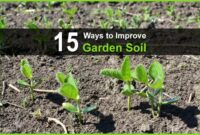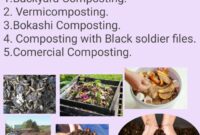How to amend clay soil: Techniques and Tips for Gardeners introduces readers to the key methods and strategies for improving clay soil composition, offering valuable insights for a successful gardening experience. Dive into the world of soil amendment and discover the secrets to cultivating thriving plants in challenging clay soil conditions.
Introduction to Clay Soil Amendment

Clay soil is characterized by its fine particles that hold water and nutrients tightly, making it dense and compact. This type of soil can be challenging for gardening due to its poor drainage and tendency to become hard when dry. Amending clay soil is crucial for improving its structure, drainage, and nutrient availability, creating a healthier environment for plants to thrive.
Why Amend Clay Soil
Amending clay soil is essential to break up its dense texture, enhance drainage, and increase aeration. By adding organic matter such as compost, peat moss, or aged manure, gardeners can improve the soil’s structure, allowing roots to penetrate easily and access nutrients more effectively. Additionally, amendments help prevent waterlogging and nutrient deficiencies, promoting healthier plant growth.
Challenges of Gardening in Clay Soil
Gardening in clay soil presents several challenges, including slow water infiltration, reduced root development, and limited oxygen availability to plant roots. The compact nature of clay soil can lead to waterlogged conditions, root rot, and nutrient leaching. Without proper amendment, plants may struggle to thrive and display stunted growth, yellowing leaves, or poor flowering. It is crucial to address these challenges by amending clay soil to create a more hospitable environment for plant growth.
Testing Clay Soil
Before amending clay soil, it is crucial to test its composition to determine its pH level and nutrient content. This information will guide you in choosing the right amendments for improving the quality of the soil.
When it comes to growing tomatoes, companion planting is a popular technique that offers numerous benefits. By strategically pairing tomatoes with compatible plants, gardeners can enhance growth, deter pests, and improve overall yield. Understanding the concept of companion planting is essential for maximizing the potential of tomato crops.
Methods for Testing Clay Soil Composition
There are several methods available for testing the composition of clay soil, including:
- Soil Test Kits: These kits can be purchased at garden centers and provide a quick and easy way to test the pH level and nutrient content of the soil.
- Laboratory Testing: Sending soil samples to a professional laboratory for analysis can provide more detailed information about the composition of the soil.
Significance of Knowing the pH Level of Clay Soil, How to amend clay soil
The pH level of clay soil indicates its acidity or alkalinity, which can affect the availability of nutrients to plants. Testing the pH level helps in determining if the soil needs to be adjusted to create optimal growing conditions for plants.
Importance of Understanding the Nutrient Content in Clay Soil
Clay soil often lacks essential nutrients needed for plant growth. Testing for nutrient content allows you to identify any deficiencies and choose the right amendments to improve the soil’s fertility. This information is crucial for promoting healthy plant growth and maximizing yields in your garden.
Ways to Amend Clay Soil

Amending clay soil is essential to improve its structure and fertility. Incorporating organic materials is a great way to enhance the quality of clay soil.
For those looking to start their own garden at home, exploring hydroponic gardening systems can be a game-changer. These innovative setups allow individuals to grow plants indoors without the need for soil. From nutrient solutions to vertical setups, there are various options to suit different preferences and spaces.
List of Organic Materials for Clay Soil Amendment
- Compost: Compost is rich in nutrients and helps break up clay soil, improving drainage and aeration.
- Manure: Adding manure to clay soil adds organic matter, improves soil structure, and enhances soil fertility.
- Peat Moss: Peat moss helps to loosen clay soil and improve its ability to retain moisture.
- Leaf Mold: Leaf mold is a great source of organic matter that helps improve soil structure and promotes beneficial microbial activity.
Process of Incorporating Organic Matter into Clay Soil
To incorporate organic matter into clay soil, you can spread a layer of compost, manure, peat moss, or leaf mold on the soil surface and mix it thoroughly into the top few inches of soil. This can be done using a shovel or a rototiller to ensure even distribution of organic materials.
When it comes to gardening, the debate between hydroponics and soil gardening continues to spark interest among enthusiasts. While hydroponic systems offer controlled environments for plant growth, traditional soil gardening provides a natural approach with its own benefits. Understanding the differences and advantages of each method is crucial for successful cultivation.
Benefits of Using Cover Crops to Amend Clay Soil
- Improved Soil Structure: Cover crops such as legumes can help break up compacted clay soil and improve its structure.
- Nutrient Cycling: Cover crops can add organic matter to the soil, enriching it with essential nutrients for plant growth.
- Weed Suppression: Cover crops can help suppress weed growth in clay soil, reducing competition for nutrients and water.
- Enhanced Soil Microbial Activity: Cover crops promote beneficial microbial activity in the soil, contributing to overall soil health and fertility.
Adding Sand and Grit to Clay Soil: How To Amend Clay Soil
When amending clay soil, adding sand and grit can be beneficial in improving drainage and preventing waterlogging. These materials help break up the dense clay particles, allowing for better aeration and water movement in the soil.
Benefits of Adding Sand and Grit
- Sand and grit help improve soil drainage by creating pore spaces for water to flow through.
- They enhance soil structure by reducing compaction and increasing air circulation.
Proper Ratio of Sand to Clay Soil
To effectively amend clay soil with sand and grit, it is recommended to use a ratio of 1 part sand/grit to 4 parts clay soil. This balanced mixture ensures that the soil is not overly sandy, which can lead to poor water retention, or too clay-heavy, which can hinder drainage.
Tips for Incorporating Sand and Grit
- Before adding sand and grit, loosen the clay soil by tilling or digging to a depth of at least 12 inches.
- Spread the sand and grit evenly over the tilled soil and mix thoroughly to ensure proper distribution.
- Avoid overmixing, as this can damage the soil structure and create a homogenous mixture that hinders drainage.
- Consider using coarse sand and grit for better aeration and drainage improvement.
Mulching and Composting in Clay Soil
Mulching and composting are essential practices when amending clay soil, as they help improve soil structure, fertility, and overall plant health.
Mulching for Moisture Retention
Mulching plays a crucial role in retaining moisture in clay soil by creating a protective barrier on the soil surface. This barrier helps reduce water evaporation, prevent soil erosion, and regulate soil temperature. Organic mulches, such as straw, wood chips, or shredded leaves, are ideal for clay soil as they break down over time, adding organic matter to the soil and improving its structure.
- Organic mulches create a protective layer that helps retain soil moisture, reducing water loss through evaporation.
- By reducing water evaporation, mulches also help prevent soil cracking and compaction in clay soil.
- Mulches promote the growth of beneficial soil organisms that aid in nutrient cycling and soil aeration.
Benefits of Composting
Composting is another effective method to amend clay soil, as it helps introduce organic matter and beneficial microorganisms into the soil. Compost improves soil structure, enhances nutrient availability, and promotes healthy root growth in plants. Additionally, composting reduces soil compaction and increases the soil’s ability to retain moisture.
- Compost adds essential nutrients to clay soil, promoting plant growth and overall soil fertility.
- Organic matter from compost helps improve soil structure, making it easier for plant roots to penetrate the soil.
- Composting encourages the growth of beneficial soil bacteria and fungi, which contribute to soil health and plant resilience.
Types of Mulch and Compost for Clay Soil
When choosing mulch and compost for clay soil, it is important to opt for organic materials that decompose slowly and add valuable nutrients to the soil. Mulches like straw, wood chips, or bark mulch are excellent choices for clay soil, while compost made from a mix of green and brown materials provides a balanced nutrient profile.
- Straw mulch is lightweight and easy to spread, making it a popular choice for covering clay soil surfaces.
- Wood chips break down slowly, adding organic matter to the soil and improving its structure over time.
- Compost made from a mix of kitchen scraps, yard waste, and manure is rich in nutrients and beneficial microorganisms, ideal for clay soil improvement.
Managing Water Drainage in Clay Soil

Proper water drainage is crucial in clay soil to prevent waterlogging and ensure healthy plant growth. Clay soil has a tendency to become compacted, leading to poor drainage and root suffocation. Here are some methods to improve water drainage and prevent waterlogging in clay soil:
Adding Organic Matter
One effective way to improve water drainage in clay soil is by adding organic matter such as compost, leaf mold, or well-rotted manure. Organic matter helps to break up clay particles, allowing water to drain more easily through the soil.
Installing Drainage Pipes
In areas where water tends to accumulate, consider installing drainage pipes to redirect excess water away from the soil. This can help prevent waterlogging and ensure that the soil remains well-drained.
Creating Raised Beds
Another option to improve water drainage in clay soil is to create raised beds. By elevating the planting area, you can prevent water from pooling and promote better drainage. Raised beds also provide better aeration for plant roots.
Avoiding Compaction
To prevent waterlogging in clay soil, avoid walking or working on wet soil as this can lead to compaction. Compacted soil restricts water movement and exacerbates drainage issues. Wait until the soil is dry before tilling or planting to maintain good soil structure.
Monitoring Watering Practices
Be mindful of your watering practices to prevent waterlogging in clay soil. Water deeply but infrequently to encourage deep root growth and allow excess water to drain away. Avoid overwatering, as this can lead to waterlogged conditions in clay soil.
Plant Selection for Clay Soil
When it comes to choosing plants for clay soil, it is essential to select species that can thrive in these challenging conditions. The right selection of plants can not only enhance the beauty of your garden but also help improve the quality of clay soil over time.
Plants That Thrive in Clay Soil Conditions
- Roses: Many varieties of roses, including shrub roses and climbers, do well in clay soil.
- Lavender: This fragrant herb thrives in clay soil and adds a pop of color to your garden.
- Daylilies: These hardy perennials can tolerate clay soil and provide beautiful blooms.
- Black-eyed Susans: These cheerful flowers are well-suited for clay soil and attract pollinators.
Improving Clay Soil with Plant Selection
Plant selection plays a crucial role in improving clay soil over time. As plants grow and establish their roots in clay soil, they can help break up the compacted soil, improve drainage, and increase nutrient availability. By choosing plants that are well-adapted to clay soil, you can create a more balanced and healthy ecosystem in your garden.
Matching Plant Species with Clay Soil Characteristics
- Consider the moisture levels: Choose plants that can thrive in the moisture levels typical of clay soil, which tends to retain water.
- Look for deep-rooted plants: Opt for species with deep root systems that can penetrate the dense clay soil and improve its structure over time.
- Check for pH compatibility: Some plants prefer acidic or alkaline soil, so make sure to select species that match the pH of your clay soil.
In conclusion, mastering the art of amending clay soil is essential for any gardener looking to enhance their green space. By implementing the techniques and tips discussed, you can transform your clay soil into a fertile ground for a variety of plants, ensuring a bountiful harvest and a vibrant garden all year round.




